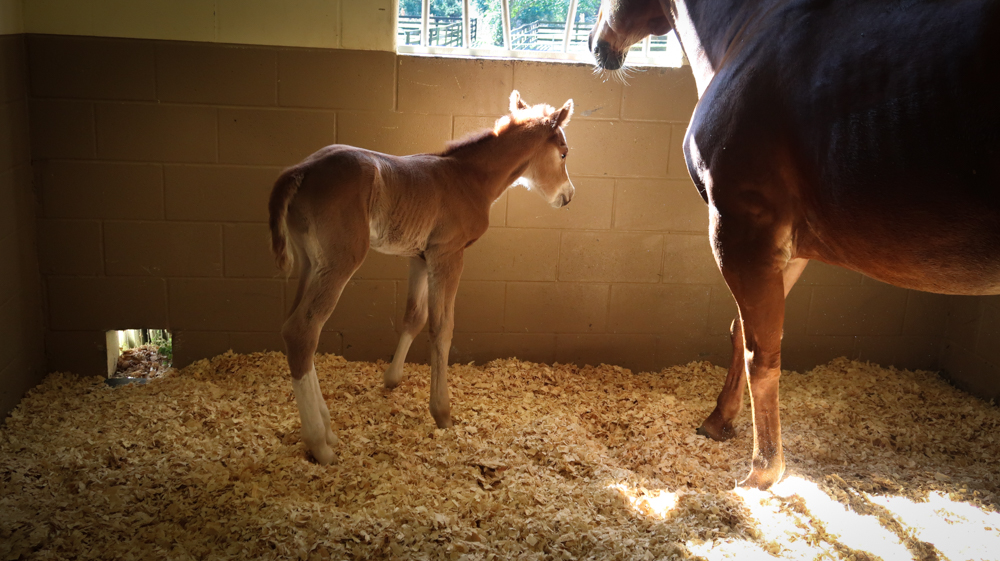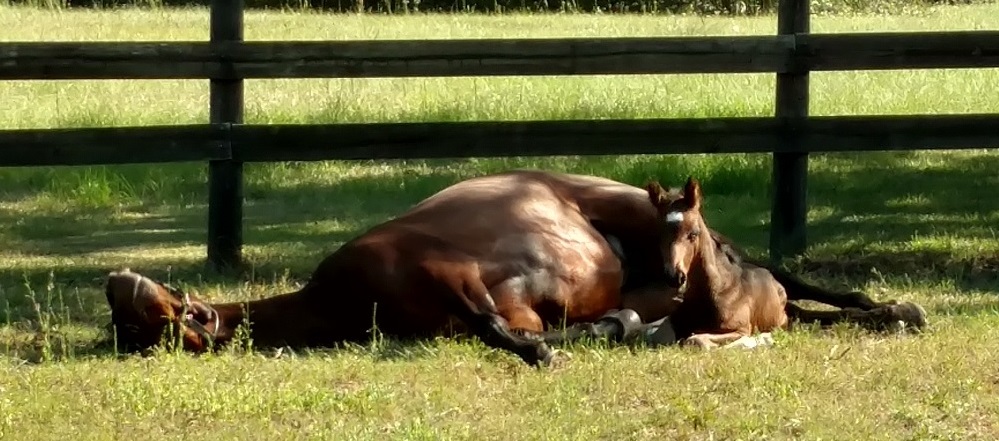Whinny’s Wisdoms

Hey everybody, Whinny here! It’s January, which means for some, the time may be approaching to start foal watch on your pregnant mare! Mares have an 11-month gestation and some breeds do their best to have a foal born as close as they can to the first of the year. Knowing the normal birth process allows us to catch any problems early and intervene if necessary.
Foal watch usually starts about 2 weeks before the mare’s foaling date. Foal watch starts with monitoring the mare’s behavior, eating habits, and changes to her body. The mare’s gluteal muscles will become very soft when she is close to foaling and her tail will also become more relaxed. Her udder will start to produce milk. We can monitor for changes in the milk by checking its pH. Once the pH of her milk drops below 7, the mare will likely foal in the next 24 hours. Click here to watch a short video demonstrating these things!

Three Stages of Parturition in Mares
Stage 1
This stage is getting the foal in position for delivery. Therefore, some of the signs, such as getting up and down, may be similar to colic. She may go off her feed intermittently. Often times, the mare may be seen rolling, pawing and frequently kicking at her abdomen. Usually these signs will diminish, the mare will return to normal, and it will be very confusing to those who are waiting for the foal to come. You may also notice that your mare has contractions. This can last for many days prior to actually having a foal on the ground. The humans tell me that this is how your mare makes sure you are exhausted before anything ever happens.
Stage 2
This stage is crazy fast and it is important to keep track of the duration of time the mare is in this stage. This stage starts when the mare’s water breaks and lasts until the foal is expelled. This should take no more than 30 minutes. This is when things can go very wrong, very quickly. The foal should be presenting front feet first, followed shortly by a nose. If it does take longer than 30 minutes, or if you see a red bag or anything other than front feet and nose, then this is a dystocia and is a medical emergency. Call your vet immediately no matter what time it is!
Stage 3
The final stage is expulsion of the placenta. This should be passed no more than 3 hours after the foal is born. If the placenta has a piece missing or has not been expelled in the appropriate time frame, this is a medical emergency for the mare. Again, call your vet no matter what time it is.
The 1-2-3 Rule
Besides the 3 stages listed above, it’s important to know the 1-2-3 Rule and keep note of the times the mare and foal are meeting important milestones. These milestones are:
- The foal should be standing within 1 hour after being born.
- The foal should be successfully nursing within 1 hour after standing (so 2 hours after being born). This is vital for a foal to receive the colostrum from their mom. This is where they receive their immune system. A foal is born without an immune system and will not have the ability to fight infection and pathogens unless it gets the colostrum from its mother.
- As mentioned above, the mare should pass her placenta no later than 3 hours after her foal is born.
Foal watch, with its meticulously delineated stages of parturition, helps ensure the health and wellbeing of your mare and new foal. Horses aren’t nearly as good at this whole reproduction thing as mice are, so they often need some help. When you’re standing in the barn at 2:00 in the morning trying to decide if you should bother your veterinarian or not, remind yourself that you have invested a tremendous amount of time, money, and heartache to get to this point. Always err on the side of caution, and don’t gamble with your mare and foal! I promise that your vet would rather respond to a false alarm than sleep through a crisis.

If all goes well with the foaling, you’ll need to have your vet come out for a new foal exam. They usually time this so that they arrive when the foal is around a day old, but also while it’s daytime. Along with a thorough physical exam, they’ll pull blood to do an IgG test, which will tell them if your foal got enough colostrum. If it didn’t, it will need plasma immediately, and they will help you with that.
This is the point that more or less closes out the end of a year of breeding insanity and begins the next chapter of madness: raising a foal! I’ll save that topic for another day. There’s a block of cheese that’s been sitting out on the desk calling my name…
Until next week,
~Whinny
P.S. Don’t forget to go watch that video! It will show you exactly what your mare will look like when it’s approaching Go Time. And while you’re on our YouTube Channel, look around! We’ve got a great video library for you, including a number of seminars on breeding and foaling which are packed with much more information than I shared here, and it’s all free! Make sure you use all the tools to do this job!
 Whinny’s Wisdoms is the official blog of Whinny the Clinic Mouse at Springhill Equine Veterinary Clinic in Newberry, Florida. If you liked this blog, please subscribe below, and share it with your friends on social media! For more information, please call us at (352) 472-1620, visit our website at SpringhillEquine.com, or follow us on Facebook!
Whinny’s Wisdoms is the official blog of Whinny the Clinic Mouse at Springhill Equine Veterinary Clinic in Newberry, Florida. If you liked this blog, please subscribe below, and share it with your friends on social media! For more information, please call us at (352) 472-1620, visit our website at SpringhillEquine.com, or follow us on Facebook!
[jetpack_subscription_form title="Subscribe to Whinny's Wisdoms"]

